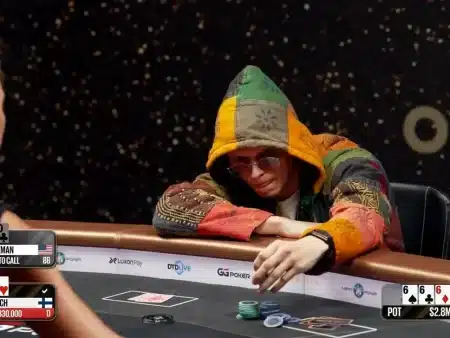Online poker tournaments have really taken off in 2025, giving players more chances to score big wins than ever before. The virtual felt’s packed with all sorts of formats—different buy-ins, structures, and prize pools that suit everyone from total newbies to seasoned pros.
If you want to do well, you’ve got to get the hang of things like ICM (Independent Chip Model), stack management, and figuring out how your opponents play. Mastering these can seriously turn your results around and help your bankroll grow.

To make it these days, you’ve got to adapt to the current meta-game and still nail the basics. It’s a balancing act—be aggressive but don’t forget about your bankroll or you’ll be out before you know it.
The best tournament players in 2025? They’re not just technically skilled; they’ve got the mental stamina to keep making good decisions, even during those marathon sessions.
Picking the right tournaments matters just as much as playing them well. Some folks focus only on in-game strategy, but honestly, tournament selection is where a lot of the profit comes from.
The top players are picky—they choose events that fit their skill, their bankroll, and their preferred structures. It’s not just about playing, it’s about playing smart.
Understanding Online Poker Tournaments

Online poker tournaments really aren’t like cash games. The structure, the strategy, and the potential rewards all hit differently.
Tournaments are super popular now, and there’s a format for everyone, no matter your style.
What Defines Online Poker Tournaments
In these events, everyone starts with the same chip stack and battles it out until one player has every last chip. Unlike cash games, your chips in a tournament don’t have any real-world value.
You’ll pay a buy-in (plus a small fee to the platform), and all the buy-ins get pooled for the prize money. Only the top finishers walk away with cash.
Blinds keep going up, so you can’t just sit around waiting for aces. You’ll need to adjust your approach as things speed up.
Once your chips are gone, that’s it—you’re out. That risk-reward balance is a whole different beast compared to cash games.
Comparison: Tournaments vs. Cash Games
Tournaments and cash games just don’t play by the same rules. In tournaments, you can’t cash out chips until the end; in cash games, you can leave whenever you want.
Key Differences:
- Risk Structure: Tournaments have set buy-ins, but the upside can be huge.
- Time Commitment: You’ll need to block out hours for a tournament.
- Skill Focus: Tournaments reward players who can adapt and stay patient.
Cash games have fixed blinds, so your strategy doesn’t have to change much. In tournaments, you’ve got to keep adjusting as blinds go up and stacks get shallow.
The mindset’s different too. Tournament players worry about surviving and building a stack, while cash game players just try to make the best decisions every hand.
Common Tournament Formats
There’s a ton of variety in online poker tournaments in 2025, and each format has its own quirks.
Freezeout Tournaments are old-school—bust once and you’re done. They reward patience and good bankroll management.
Re-buy Tournaments let you buy more chips if you bust early. Expect wild, aggressive play at the start and bigger prize pools.
Turbo and Hyper-Turbo tournaments crank up the speed with fast-rising blinds. These are over in a flash and favor players who aren’t afraid to shove it in.
Multi-Table Tournaments (MTTs) can have hundreds or even thousands of players, with massive prize pools up for grabs. But be warned: they can take all day.
Sit & Go tournaments are smaller, starting as soon as the seats fill. Perfect if you don’t have hours to spare.
Types of Poker Games and Tournament Structures
Knowing your way around the different poker variants and tournament setups is a must if you want to win consistently online. Each one brings its own set of challenges and strategies.
Texas Hold’em and No-Limit Hold’em
Texas Hold’em still rules in 2025, especially the No-Limit version. You get two cards, five community cards, and you’re always trying to build the best hand.
No-Limit Hold’em is the wild west—you can shove all your chips in whenever you want. That’s why it’s the star of the big tournament series like the WSOP and most online rooms.
Limit Hold’em is more controlled, with fixed bet sizes. It’s less about bluffing and more about math and technical play.
Here’s a quick breakdown:
| Format | Betting Style | Skill Emphasis | Popularity |
|---|---|---|---|
| No-Limit | Any amount | Risk management, psychology | Very High |
| Limit | Fixed amounts | Technical play, math | Moderate |
Omaha, Stud, and Razz
If you’re bored with Hold’em, there’s Omaha, Stud, and Razz to shake things up.
Omaha gives you four hole cards, but you have to use exactly two, plus three from the board. Pot-Limit Omaha (PLO) has gotten super popular—it’s action-packed and can be tough to master.
Seven-Card Stud skips community cards. You get seven cards, three down and four up, and try to make the best five-card hand. It’s a memory game as much as anything.
Razz flips things—lowest hand wins. You want the worst possible hand, with A-2-3-4-5 (“the wheel”) being the nuts.
SNGs, MTTs, and Spins
Tournament structure changes the whole game plan.
Sit and Gos (SNGs) start as soon as all seats are filled. Usually just one table, so you know what you’re getting into time-wise. Early on, play tight; as you get closer to the end, you’ll need to open up and get aggressive.
Multi-Table Tournaments (MTTs) kick off at a set time and can have a sea of players. The prize pools are huge, but you’ll need stamina and the ability to switch gears as stacks and opponents change.
Spin & Go tournaments (or just “Spins”) are three-handed, super-fast, and the prize pool is a bit of a lottery. They’re fun, unpredictable, and can pay out huge for a tiny buy-in.
Hyper Turbo, Rebuys, and Add-Ons
How fast a tournament moves and what re-entry options you have can make or break your strategy.
Hyper Turbo events have blinds that shoot up fast, and stacks start short. These games are over in under an hour, so be ready to push or fold with little hesitation.
Rebuy tournaments let you buy more chips if you bust or fall below a certain stack early on. It’s a license for players to gamble hard at the start.
Add-On periods give everyone a one-time chance to buy more chips, usually after the rebuy phase. Sometimes, this is the best chip value you’ll get.
Quick structure rundown:
- Freezeout: Bust once and you’re done.
- Rebuy: Multiple buy-ins during early levels.
- Progressive Knockout: Knock out a player, collect a bounty that grows.
- Satellite: Win a seat in a bigger event instead of cash.
Mastering Tournament Strategy in 2025
Tournament poker isn’t the same as cash games. You’ve got to think about changing blinds, payout ladders, and how players shift gears as the tournament goes on.
Key Phases: Early, Middle, and Late Game
Early on, just play it safe. Stick to strong hands and don’t take silly risks while the blinds are small. It’s all about building a stack, bit by bit, and targeting weaker players.
Once you’re in the middle stages and the blinds start to bite, it’s time to open up. Look for chances to steal pots, especially from late position.
Late game? That’s where things get tense. As you get close to the money, players tighten up, so you can get away with more aggressive moves. Use that to your advantage.
Always keep an eye on stack sizes. Medium stacks tend to play scared, while short stacks are desperate and willing to gamble.
Adapting to Blinds and Bet Sizing
Blinds don’t wait for anyone. As they climb, you’ve got to change gears. If the blinds are less than 5% of your stack, you can chill. Once they’re over 10%, you need to start making moves.
Adjust your bet sizing as you go. Early on, 2.5-3x the big blind works. Later, shrink it down to 2-2.5x to save chips but still build pots.
In the late stages, value bets should be smaller—pros these days go for 50-60% pot. It’s about squeezing out value without risking too much.
Watch how your opponents size their bets. Weirdly big or tiny bets can give away their hand strength—don’t miss those clues.
Winning Strategies for Small Stakes and Low Stakes Poker
If you’re grinding small stakes, just keep it simple. Play tight and aggressive, don’t get fancy. Most players will make obvious mistakes—let them.
Learn ICM (Independent Chip Model) so you know when your chips are actually worth risking, especially near payout jumps.
A lot of low stakes players overvalue weak hands. Punish that by value betting more and bluffing less than you would against tougher competition.
Keep track of your results. Most sites have solid analytics these days. After each session, review your hands and look for leaks. Even tiny tweaks add up over time.
Essential Poker Skills and Table Dynamics
Online tournament success isn’t just about knowing the math. You need technical skills, but also the ability to read people and control your own emotions.
That mix—good hands, good position, and a cool head—sets you up for consistency.
Choosing Starting Hands for Tournaments
In tournaments, you can’t splash around early. Stick to premium hands like AA, KK, QQ, and AK. Survive and build your stack without taking dumb risks.
As the blinds go up, start loosening up a bit. In the middle stages, toss in suited connectors and small pairs. They can win you big pots if you hit the right flop.
Position is everything. Early on, only play the top 10% of hands. From late position, you can widen your range, especially if the table’s soft.
Tournament Stage Hand Selection Guide:
- Early: Only play the big guns (AA-TT, AK-AQ)
- Middle: Add suited connectors and small pairs
- Late/Bubble: Get aggressive in late position, sometimes with any two cards
Heads-Up Play and Final Table Adjustments
When you hit the final table, everything changes. Fewer players means position matters even more, and the button becomes a license to steal.
Heads-up, you need to be fearless. Play 70-80% of your hands on the button, raising constantly to put the big blind under pressure.
Stack sizes matter a ton at the end. Medium stacks usually play it safe, hoping to move up in the payouts—attack them.
ICM (Independent Chip Model) comes into play here. Sometimes, folding a strong hand is the right move if the pay jumps are big enough. Get comfortable with these spots—it’s a real edge.
Managing Tilt and Emotional Control
Tilt is a killer in tournaments. Bad beats happen, but if you let them get to you, you’ll go broke fast.
Have a plan for tilt. If you feel yourself slipping, take a quick break, do some deep breathing, or just play only the best hands for a round.
Physical stuff matters too—sleep, water, and breaks help you stay sharp. Long sessions can really wear you down.
Tilt Prevention Checklist:
- Decide your stop-loss limit before you start
- Take a breather after a nasty beat
- Focus on making good decisions, not just results
- Keep a poker journal to spot emotional patterns
Maximizing Value: Prize Pools, Buy-Ins, and Managing Your Bankroll
If you want to last in online poker, you need to be smart about your bankroll and the tournaments you choose. These decisions shape your risk and reward every time you play.
Understanding Prize Pool Distribution
Most online tournaments have prize pools that are top-heavy. The winner usually gets 15-30% of the money, and the payouts drop off fast from there.
Typically, only the top 10-15% of players get paid. In a 1,000-player event, that’s about 100-150 players cashing.
Common Prize Pool Structures:
- Regular tournaments: Top 3 finishers split about half the prize money
- Flatter structures: More even payouts, often in satellites
- Progressive knockouts: You earn extra for every player you bust
A lot of sites now show the full payout structure before you sign up. Use that info to pick tournaments that fit your goals and your style.
Buy-Ins, Tournament Fees, Rebuys, and Add-Ons
Tournament costs are a bit more layered than they first appear, and each piece can impact both your investment and what you might walk away with.
Buy-in components:
- Main buy-in: This part goes straight into the prize pool.
- Tournament fee: The site’s cut, which usually falls somewhere between 5-15%.
So, for a $100+$10 event, your $100 feeds the prize pool, and the $10 is the platform’s fee. Pretty straightforward, but not always obvious at first glance.
Additional investment options:
- Rebuys: These let you buy more chips if you’re knocked out or drop below a certain stack.
- Add-ons: Extra chips you can snag at specific break times.
Tournaments with rebuys and add-ons tend to build larger prize pools, but you’ll need to think carefully about how much more you’re willing to invest. It’s a good idea to figure out your max exposure before you even sit down.
If you’re hunting for value, keep an eye out for tournaments with lower fees and smart rebuy spots.
Bankroll Strategy for Online Poker
Managing your bankroll is a must if you want to survive in the poker world, especially with how tough the games are getting in 2025.
Recommended bankroll requirements:
- Cash games: Aim for 20-30 buy-ins at your regular stakes.
- Tournaments: 50-100 buy-ins is the safer route for your average entry.
If you’re new to the game, sticking to 50 buy-ins for any limit is just common sense. More seasoned players might risk a bit less—maybe 30-40 buy-ins—if they’re confident in their edge.
Don’t ever put more than 5% of your total bankroll into one tournament. For a whole tournament series, try to cap your risk at 15-20% of your roll.
Keep track of your results, whether you use software or just a simple spreadsheet. It’s a bit of a hassle, but you’ll thank yourself later when you can spot which formats or buy-ins are actually making you money.
Only move up to higher stakes after you’ve shown steady profit at your current level and have the bankroll cushion to handle the swings.
Getting Started: Platforms, Deposits, Bonuses, and Security
Kicking off your online poker journey means thinking carefully about where you play, how you move your money, what bonuses are out there, and how to keep your account safe. These basics can really shape your whole experience.
Selecting an Online Poker Room
In 2025, there are a handful of poker sites that get high marks from both experts and regular players. When you’re picking a site, look at the game selection, how busy the tables are, and whether the software feels good to use.
Sites like PokerCoaching.com and PokerNews tend to recommend platforms with a solid mix of games—Texas Hold’em, Omaha, and plenty of tournament action. Personally, I’d rather play somewhere with a clean interface that works well on both desktop and mobile.
Active player communities are a big plus too. If you can’t find a game at your stakes when you want to play, what’s the point? This is especially true for US players, since choices can be a bit limited.
Rake structure matters more than you might think. Lower rake (usually 3-5%) means you keep more of your winnings. Some sites even have rakeback, which is basically getting a little bit of your paid rake returned to you—a nice bonus.
How to Deposit and Claim Bonuses
Most poker rooms accept all kinds of payments: credit cards, e-wallets, even crypto. Bitcoin and other cryptocurrencies are getting more popular since they usually mean faster cashouts and a bit more privacy.
Deposit minimums are generally between $10 and $50, but the max depends on the method and site. Deposits are usually instant, but withdrawals can take anywhere from a few hours to a few days.
Welcome bonuses almost always match your first deposit—100% up to a certain amount. You’ll unlock the bonus in small chunks as you play and pay rake.
Bonus Clearing Requirements:
- Most bonuses release in $5-10 steps.
- You’ll need to generate 5-10 times the bonus in rake.
- There’s usually a 30-90 day window to clear it.
It’s worth reading the fine print before you claim any bonus. Some of those requirements sneak up on you.
Ensuring Privacy and Account Security
Two-factor authentication (2FA) is basically standard now, and you should always turn it on for your poker accounts.
Pick a strong, unique password—don’t recycle one you use elsewhere. It’s not worth the risk.
Be extra careful about screen sharing, especially if you’re streaming or reviewing hands with friends. Even a quick flash of your account info can be trouble.
Legit poker sites use SSL encryption, so always check for that little padlock icon in your browser before entering any personal details.
If you’re really cautious, set up a separate email just for poker. It helps keep phishing attempts at bay and keeps your poker stuff out of your regular inbox.
Recommended Resources and Best Poker Books
Essential Poker Books for 2025:
- The Modern Poker Theory” by Michael Acevedo
- Exploitative Play in Live Poker” by Alexander Fitzgerald
- The Mental Game of Poker” by Jared Tendler
If you’re looking to dive deeper, online training sites like PokerCoaching.com have a ton of structured courses. These are taught by pros who know what they’re doing, and honestly, the hand analyzers and quizzes can be pretty eye-opening.
There are also strategy videos, which are sometimes more helpful than you’d expect. Not everyone learns the same way, so it’s nice to have options.
Poker tracking software is a huge help for analyzing your play. Tools like PokerTracker and Hold’em Manager are pretty much the go-to choices, and they work with most of the big poker sites.
And hey, don’t underestimate the power of a good community. Reddit’s poker spaces and some classic forums are packed with advice, hand reviews, and honest site recommendations from people who’ve been around the block.













